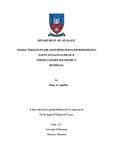Characterisation and groundwater flow remodelling, Dukwi wellfield phase 11, North Eastern Sub-District Botswana
Date
2016-08-03Author
Legadiko, Oteng. D.
Link
UnpublishedType
Masters Thesis/DissertationMetadata
Show full item recordAbstract
Dukwi WellField phase II groundwater flow model has been audited, remodelled and updated to 2015. The current model (2015 DWM) is a three dimensional groundwater flow model. The model covers Phase II of the wellfield while the former were two dimensional groundwater flow models and covered the Dukwi regional wellfields of which some were decommissioned over time. The remodelling exercise serves to rationalize, update and upgrade the previous DWM, its audits and to incorporate them into one integrated model that will describe the entire area to greater detail. The exercise involved reconstruction of the Model slices and structures using the geological and hydrogeological data at hand. The most striking findings of the 2015 Dukwi wellfield Phase II model are its contrasting water resources quantitative simulations in relation to the former DWM. The current model reflects a simulated recharge of 2800 m3/d, simulated abstraction of 4517 m3/d and simulated available water resources of 1630 m3/d, while the latest former Dukwi Wellfield water resource evaluation studies (DWA, 2008) reflected simulated values of 3493 m3/d, 6758 - 10137 m3/d and 3379 m3/d, respectively. The former Dukwi Welfield water resources evaluation studies (DWA, 2008) further predicted maximum drawdown of 37m by the year 2059, for a close period by the year 2055 the current model predicted maximum drawdown of 13m. The minimum available drawdown for the Dukwi WellField is about 25m, the current model simulations therefore reflects that the aquifer system can sustain the demand beyond the year 2055. The 2015 DWM provides information that serves as a tool for understanding the aquifer system and its behaviour in its current state; it is also useful for predicting its responses (water levels and drawdowns) and volume fluxes of the ground water resources for implementation of management alternatives like increased or decreased abstraction.

